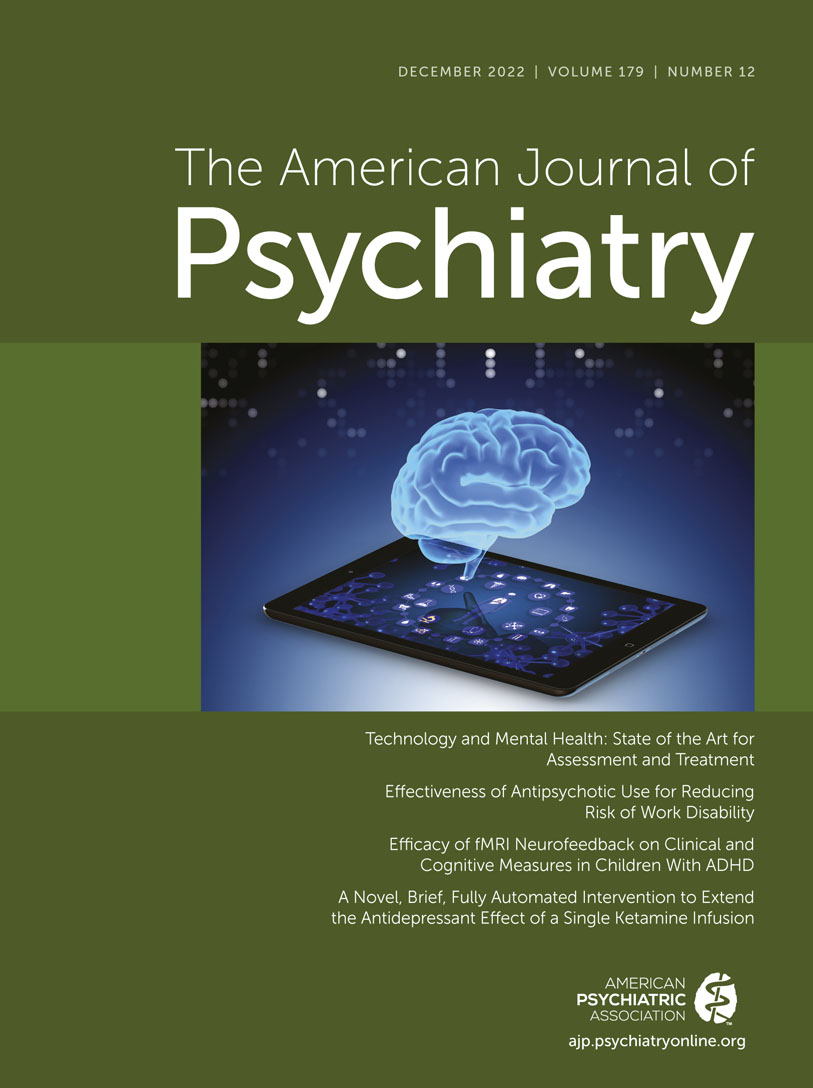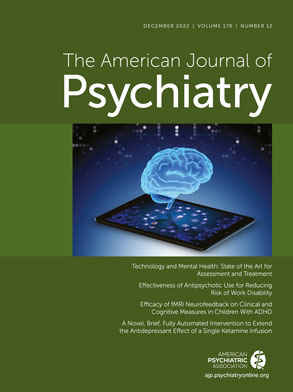Prescribing naltrexone for alcohol misuse continues to be one of the most underutilized interventions in medicine.
Alcohol use disorder (AUD) is among the most devastating health conditions in the United States. Although deaths from opioids and other substances garner more attention, at least 80,000 deaths annually are attributable to alcohol use (
1,
2). The COVID-19 pandemic has exacerbated problematic alcohol use, especially among women and non-Hispanic Black individuals (
3). The range of medical and psychiatric consequences of alcohol use is well documented. We now know more about the harmful impact of binge drinking and even mild to moderate amounts of alcohol intake. Binge drinking in particular is common (it occurs among one-fifth of adults in the United States) and is detrimental to health, contributing to half of the annual deaths from alcohol (
1,
2).
Most interventions to address AUD have existed for decades. The oral formulation of naltrexone has been approved for AUD for almost 30 years, and the long-acting injectable formulation has been around since 2006. Alcoholics Anonymous (AA) has been around for almost a century.
Despite the long-standing existence of these interventions, millions of individuals with AUD leave their clinician’s office with little to counter their alcohol misuse. The reasons for this are many, including, among others, lack of knowledge and skills in addressing addiction; stigma; and rejection of the disease model of addiction (
4). It is certainly not due to the lack of evidence or approval for these interventions.
In addition to naltrexone (oral and long-acting injectable), acamprosate and disulfiram are approved by the U.S. Food and Drug Administration (FDA) for the treatment of AUD. There is evidence for the efficacy and tolerability of topiramate, gabapentin, and other medications as well (
5). Clinical practice guidelines, including the APA Practice Guideline for the Pharmacological Treatment of Patients With Alcohol Use Disorder (
6), have long been in place to encourage the use of these medications. There is also a growing array of psychosocial interventions for AUD beyond AA.
Among approved medications, daily naltrexone and long-acting injectable naltrexone have perhaps the strongest evidence for their use. They have been shown to improve numerous drinking outcomes, including a return to any drinking and a return to heavy drinking (
5). As an opioid antagonist that alters dopamine release following alcohol use, naltrexone is thought to help with craving and alcohol-related euphoria.
One limitation of the existing evidence for medications is that most studies on problematic alcohol use and medications for AUD focus on severe AUD and ignore binge-drinking populations. More innovative ways of incorporating medications into treatment are rarely examined as well, such as the targeted dosing of medications.
The use of targeted naltrexone often comes to patients’ and clinicians’ attention through a provocative 2015
Atlantic article entitled “The Irrationality of Alcoholics Anonymous” (
7). The article highlights the story of neuroscientist John Sinclair and his discovery that prescribing naltrexone 1 hour before drinking improves drinking outcomes by decreasing the reward of and cravings for alcohol, which may be especially helpful for binge drinkers.
In this issue of the
Journal, the study by Santos et al. offers insight into the efficacy of targeted naltrexone and highlights its use among sexual and gender minority men (SGM) (
8). Participants with mild to moderate AUD were instructed to take one pill during periods of alcohol craving and/or when they perceived high-risk events for binge drinking. The results were impressive: naltrexone reduced days and weeks with binge drinking, number of drinks consumed, and craving. The effects were sustained at 6 months posttreatment. Retention and engagement with care were also quite high. The dose used in the study (and most often in clinical practice) was 50 mg.
Targeted naltrexone may be an especially effective intervention for binge-drinking populations, who often have been difficult to engage in treatment, such as college students or SGM. Binge drinking is associated with numerous bad outcomes in these groups, from unintentional injuries to serious medical problems. Santos et al. highlight the association between binge drinking and HIV-related sexual risk behaviors and HIV infection in SGM (
8).
Naltrexone is also an ideal medication for those who are looking to moderate their use. Moderation is often a goal of treatment for individuals struggling with their alcohol use (
9), and naltrexone can provide a tool for individuals to use as they explore the role of alcohol in their lives.
Another important takeaway from this study and the broader literature on naltrexone is that prescribing naltrexone is straightforward and offers a flexible strategy that may optimize adherence. Patients can take a 50-mg dose daily (or receive the monthly injection), or just take it in a targeted fashion. Patients can take it if they are abstinent from alcohol (or desire abstinence) or if they just want to reduce their drinking.
There is little to worry about in terms of side effects from naltrexone, with a few exceptions. Patients cannot take naltrexone if they are currently on opioids. (It is an FDA-approved intervention for opioid use disorder, but one must be off of opioids for a period of time before starting it.) Naltrexone is metabolized by the liver and should be avoided in patients with severe liver disease. In the Santos et al. study, the main side effects were nausea and headache, but overall rates of adverse events in the study were similar between the placebo and naltrexone groups (
8). Weight loss is another known side effect of naltrexone (
10).
There need to be greater efforts to train clinicians on the uses and effectiveness of naltrexone. There have been significant national strategies to train clinicians to prescribe buprenorphine and other medications for opioid use disorder. Given the evidence for naltrexone and its safety profile, there should be a similar push to encourage all clinicians—from psychiatrists to primary care clinicians—to prescribe naltrexone for alcohol misuse. Clinicians surveyed on naltrexone report unfamiliarity with using it, and some believe the client needs to be in a dedicated addiction program to receive naltrexone (
11). We have a long history of telling patients they should go to AA meetings or do something about their drinking; now all providers can easily help individuals with a simple prescription.
Of course, prescribing naltrexone is just one tool for, and approach to, helping individuals who are struggling to reduce their alcohol use. Clinicians should stay up-to-date on the whole menu of treatments for AUD, as they would for any other psychiatric or medical condition that they treat. All of the psychosocial and medication treatments for AUD remain underutilized. Notably, many of the other medications can also be used in a targeted way by clinicians. Disulfiram, for example, which prevents the breakdown of alcohol and can serve as an aversive barrier to drinking, can be taken by individuals before a high-risk event.
There is a still a lot of work needed to understand how to optimize our treatments for AUD and binge drinking. Further research is needed to explore the potential of targeted naltrexone and other medications for AUD and how best to incorporate them into existing models of care. Treatments overall for binge drinking and high-risk populations deserve greater attention. There may be a role for telehealth and mobile apps in engaging difficult-to-engage populations in addressing their drinking. In addition, as in other fields of medicine, a more personalized approach should be emphasized by identifying which patients can moderate their use, which need to be abstinent, and how these goals might be set.
If we can all finally start prescribing at least naltrexone to our patients struggling with alcohol use, however, that is a good start.

